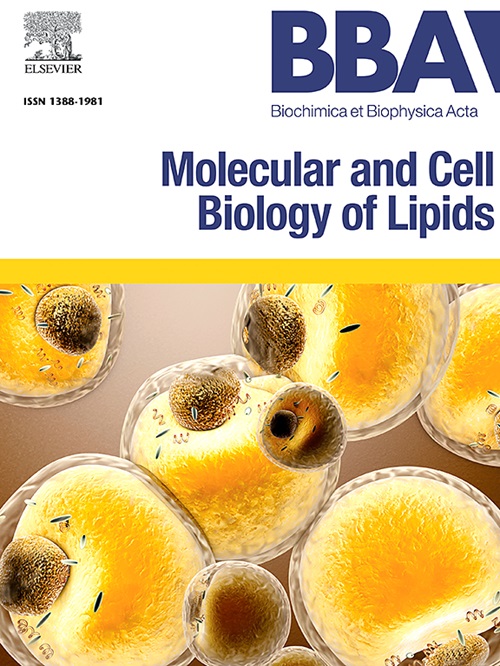部分抑制脂肪CIDEC通过激活ATGL-PPARα途径改善高脂饮食小鼠的胰岛素敏感性和增加能量消耗
IF 3.3
2区 生物学
Q2 BIOCHEMISTRY & MOLECULAR BIOLOGY
Biochimica et biophysica acta. Molecular and cell biology of lipids
Pub Date : 2025-07-07
DOI:10.1016/j.bbalip.2025.159659
引用次数: 0
摘要
肥胖会导致代谢紊乱,如胰岛素抵抗和代谢相关脂肪性肝病(MAFLD),但有效的治疗方法仍然有限。细胞死亡诱导DNA碎片因子-α样效应因子C (Cell Death-Inducing DNA Fragmentation Factor-α-Like Effector C, CIDEC)是脂滴膜蛋白,促进脂滴融合,对脂肪组织扩张至关重要,是肥胖及相关代谢疾病的关键靶点。然而,先前的研究表明,脂肪组织中Cidec的完全基因缺失,在减少脂肪积累的同时,在高脂肪饮食(HFD)喂养的小鼠中诱导了严重的胰岛素抵抗,这可能是由于肝脏中的异位脂肪储存。考虑到完全敲除是一种极端的方法,部分抑制具有更大的临床意义。因此,本研究旨在探讨部分抑制脂肪组织中CIDEC对小鼠脂肪积累和胰岛素敏感性的影响。使用Cre-LoxP系统,我们产生了脂肪单倍体不足的小鼠。在标准饮食下,这些小鼠表现出正常的体重、脂肪积累和胰岛素敏感性。值得注意的是,在HFD条件下,部分Cidec缺乏的小鼠脂肪组织中的脂肪积累减少,而肝脏脂肪积累保持不变,并伴有胰岛素敏感性改善和能量消耗增加。在机制上,我们发现部分Cidec缺乏通过ATGL-PPARα途径激活体内和体外脂肪细胞的产热程序。综上所述,脂肪部分抑制CIDEC通过增强atgl - ppar α-介导的能量消耗来减轻hfd诱导的肥胖和胰岛素抵抗,使该方法成为肥胖和相关代谢疾病的一种有前景的治疗策略。本文章由计算机程序翻译,如有差异,请以英文原文为准。
Partial inhibition of adipose CIDEC improves insulin sensitivity and increases energy expenditure in high-fat diet-fed mice via activating ATGL-PPARα pathway
Obesity poses a significant risk for metabolic disorders, such as insulin resistance and metabolic-associated fatty liver disease (MAFLD), yet effective treatments remain limited. Cell Death-Inducing DNA Fragmentation Factor-α-Like Effector C (CIDEC), a lipid droplet membrane protein, facilitates lipid droplet fusion and is crucial for adipose tissue expansion, making it a key target for obesity and related metabolic diseases. However, previous research revealed that complete genetic deletion of Cidec in adipose tissues, while reducing fat accumulation, induced severe insulin resistance in high-fat diet (HFD)-fed mice, potentially due to ectopic fat storage in the liver. Given that complete knockout is an extreme approach, partial inhibition holds greater clinical relevance. Therefore, this study aimed to investigate the effects of partial inhibition of CIDEC in adipose tissues on fat accumulation and insulin sensitivity in mice. Using the Cre-LoxP system, we generated adipose Cidec haploinsufficient mice. Under a standard diet, these mice exhibited normal body weight, fat accumulation, and insulin sensitivity. Notably, under HFD conditions, mice with partial Cidec deficiency showed reduced fat accumulation in adipose tissues while hepatic fat accumulation remained unchanged, accompanied by improved insulin sensitivity and increased energy expenditure. Mechanistically, we found partial Cidec deficiency activated thermogenic program in adipocytes in vivo and in vitro through the ATGL-PPARα pathway. In conclusion, adipose CIDEC partial inhibition attenuates HFD-induced obesity and insulin resistance by enhancing ATGL-PPARα-mediated energy expenditure, establishing this approach as a promising therapeutic strategy for obesity and related metabolic diseases.
求助全文
通过发布文献求助,成功后即可免费获取论文全文。
去求助
来源期刊
CiteScore
11.00
自引率
2.10%
发文量
109
审稿时长
53 days
期刊介绍:
BBA Molecular and Cell Biology of Lipids publishes papers on original research dealing with novel aspects of molecular genetics related to the lipidome, the biosynthesis of lipids, the role of lipids in cells and whole organisms, the regulation of lipid metabolism and function, and lipidomics in all organisms. Manuscripts should significantly advance the understanding of the molecular mechanisms underlying biological processes in which lipids are involved. Papers detailing novel methodology must report significant biochemical, molecular, or functional insight in the area of lipids.

 求助内容:
求助内容: 应助结果提醒方式:
应助结果提醒方式:


